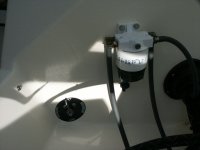My CD 22 has twin 20-gal tanks held in place by Seaboard and a strap and two runners screwed into the cockpit sole. It's time to clean them, I have a few questions:
How do I go about this (tips, tricks, etc)? If I remove the strainer/supply tube, what sealant do I use when re-connecting it? Do I need to remove the runners, if so how to screw them back down? Do I also want to replace the filter element in the Racor separator, if so, does it just screw out (sure is on tight...)
Thanks to all for any advice... :roll:
How do I go about this (tips, tricks, etc)? If I remove the strainer/supply tube, what sealant do I use when re-connecting it? Do I need to remove the runners, if so how to screw them back down? Do I also want to replace the filter element in the Racor separator, if so, does it just screw out (sure is on tight...)
Thanks to all for any advice... :roll:

